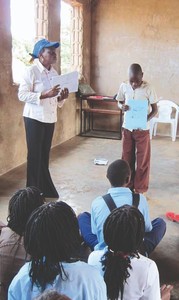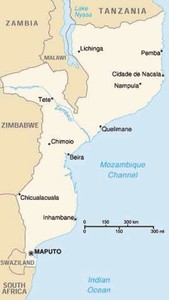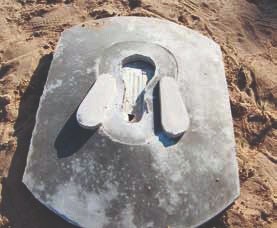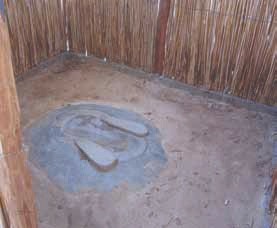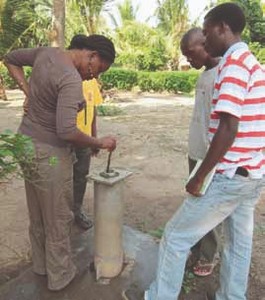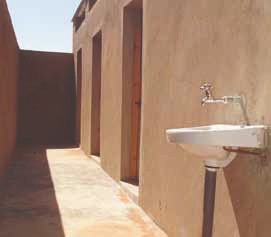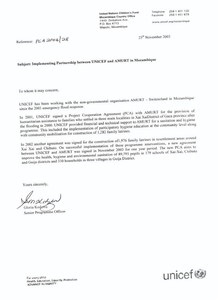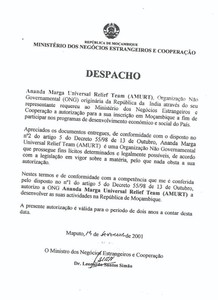
Emergency aid, clean water, hygiene and sanitation promotion
Project in numbers
| heading of table | |
|---|---|
| label | number |
Context
In 1992, Mozambique emerged from a ferocious 17 year civil war. Though the country has been stable now, the effects of the war remain and the majority of its inhabitants are still living in poverty, without safe drinking water and with barely enough food to survive.
Cyclone disaster in 2000
AMURT started its interventions in Mozambique in 2000, when exceptionally heavy rains caused massive flooding which were in turn exacerbated by the breaking of riverbanks. Additionally at this time, cyclone Eline hit the country. About 950,000 persons were in need of immediate emergency help, 190,000 of them being children under 5 years of age. In the end, 250,000 persons were displaced .
At that time, AMURT dispatched a relief team to Mozambique and delivered emergency aid to 8,000 people. Later on, in cooperation with the communities, AMURT reconstructed 800 homes for flood victims, providing construction material and technical advice. Since then, AMURT has concentrated on Water and Sanitation activities due to their dire need in almost all of the regions.
Health and Hygiene in Xai-Xai and Chibuto
Objective
The objective of the project is to improve the health of the population through sensitization promotion in health and hygiene. Eight rural communities in the districts of Xai-Xai and Chibuto will benefit from these trainings.
Narrative
In October 2011 AMURT Mozambique started to implement the first phase of the project of Health and Hygiene in the rural communities of Xai-Xai, in the Health Centers of Julius Nyerere and Chipenhe. The local leaders were contacted and solicited to present local community members to be candidates as activists. A process of pre-selection was held and on the 10–12 of November, the formation was facilitated by the officers of the Water and Sanitation Department (DAS) and District Health, Women and Social Action Service of Xai-Xai (SDSMAS-XX). Twenty activists participated in the training for health and hygiene and had started to make field visits in their respective communities. Erasmo Matusse, the head nurse of Julius Nyerere Health Center, Deodita Artur and Maria de Ceu of Department of Water and Sanitation were the facilitators.
While AMURT Mozambique is working on the project of training communities in repairing boreholes in the four districts of Gaza Province, this health and hygiene project complements the action.
Training
The formation of the selected activists have included the following topics like the identifications of common and morbid diseases e.g. cholera, diarrhea, malaria, tuberculosis, HIV/ AIDS, and pneumonia; participative techniquein working with communities e.g. how to use of the PHAST methodologies (Participative Hygiene and Sanitation Tools); transmission routes and barriers of diarrheal diseases; importance of hand washing; duties and functions of school health in-charges; and training for repairs and maintenance of borehole pumps.
Sanitation
The sanitation promotion as part of the activities of the activists in their visits to the communities and schools include the campaign for the constructions and proper use of latrines, the hand washing practices especially during the critical times, cleaning of the house and backyards, maintenance of kitchen ware by constructing “copa sanitaria” (improvise table that serves as sink for washing the plates, spoons, pots, etc.); proper conservation of food and potable water and the digging of “aterro sanitario” (holes for burying organic garbage).
School Child to Child Sanitation Clubs (CCSC)
10 schools were organized and formed CCSC. They were held at the Health Posts of Chipenhe and Julius Nyerere. The list of the schools are noted below. Initial meetings and preparations in other schools were held by activists. As most of the students in many schools in this period had left for the holidays while those who remain in the last classes had been busy for the final exams. The visits by activists monitors the sanitation situations of the schools as well as the orientations with the school health in-charges were done.
Health
The activists from their respective health center areas reports to the head nurse and the collections of data are underway.
At present, the most concerning diseases that affects the majority of the population in the area of Julius Nyerere and Chipenhe are diarrhea, due to the rainy season and the abundance of mangoes; malaria as mosquitoes are more active in this period, and tuberculoses which is one of the opportunistic disease of HIV/AIDS. Many Mozambican workers migrate to South Africa and are earning their salaries by doing some work in the mines. One consequence is that they are in some cases detected with HIV/AIDS and also infect their wives when they are back in Mozambique. The sensitization training about HIV/ AIDS is therefore necessary. The concerning activists also meet the community leaders and members to promote health and hygiene, encouraging the people to go to the health posts and health centers in any case of diseases. While the practice of going to the traditional healers is still very common, the community members are oriented to have individual new blades to be used for them by the traditional healers. This is to avoid infections especially the HIV virus.
Conclusion
This health and hygiene project highlights the capacity building from the local human resources by the process of selecting and forming the local members of the communities in the health and hygiene practices as well as the technique of transmitting basic knowledge to the other members of the community who are not aware of the advantages and importance of health centers and the treatments. Even though still in the initial phase, the project is already showing positive responses as it touches distant villages attached to the focus health center and updates the information, education and communication to the local people regarding the available health services as well as the hygiene practices.
This project on health and hygiene corresponds well with our other projects and will have a sustainable effect.
Project Partners
WFP, UNICEF, Japanese Embassy
DEZA (Department for Development and Cooperation, Switzerland)
Foundation „Life for All“


